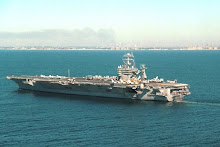For my birthday yesterday, I got three books that I am pretty excited about: “The Terrible Hours” by Peter Maas, “We Were Soldiers Once…And Young” by Harold G. Moore & Joseph Galloway, and “An American Daughter Gone to War” by Winnie Smith. I’m already halfway through “The Terrible Hours”, and it’s an incredible story.
On May 23, 1939 the newly commissioned USS Squalus (SS-192) was off the coast of Portsmouth, New Hampshire conducting her 19th test dive. After reaching a depth of about 60 ft. they experienced a critical failure of the 31” main induction valve, which fed air to the diesel engines, and had been closed at the start of the dive. Massive flooding ensued, and the Captain ordered the main and bow ballasts blown to try and surface. The Squalus gained an up angle, but the flooding was too severe and it sank by the stern, coming to rest at nearly 250 ft. off the Isle of Shoals. All electric power and propulsion was lost; the aft battery/crew’s quarters, the forward and aft engine rooms, and the aft torpedo rooms were completely flooded. Because of the skill of the highly trained crew who responded immediately to the flooding, the watertight doors were closed very quickly and 33 of the 59 crew aboard found safety in the forward torpedo room and control room.
A massive search effort was launched after the Squalus failed to report in as expected after the dive, though because of a mistranslation of the coordinates the boat sent in Morse code indicating their dive location, the searching ships were nearly 5 miles from where the Squalus actually lay. The sub launched a marker buoy and multiple flares, one of which was seen and the ships were able to close on their position. This was before the days of sonar however, and their exact location could not be pinpointed with accuracy since the line connecting the marker buoy to the sub had parted when hauled aboard one of the ships. Efforts were made to communicate with the Squalus using submerged oscilloscopes, the sub’s crew valiantly trying to respond by hammering on the hull in Morse code. After surviving dozens of hours in near-freezing temperatures and increasingly toxic atmospheric conditions, 33 men were rescued.
Beyond the skill and heroism of the Squalus’ crew, what makes this story so remarkable was that they were actually able to be rescued. A few short years previously, a rescue at that depth would have been impossible. During those days, submarine duty was called the “Coffin Service”—if anything went wrong while submerged, unless the sub happened to be in warm and very shallow water, there was no hope of escape. The 33 men of the Squalus owe their successful escape to one man: Charles ‘Swede’ Momsen.
Momsen was a Naval Academy graduate, a line officer, and a technical and scientific whiz. In 1925, while commanding the S-1 (SS-105) submarine, his sister ship the S-51 collided with a cargo ship and went down. Momsen was involved in trying to locate the S-51, and eventually found its oil slick. The downed sub was at 130 ft, and there was no way to rescue them. On board the S-51 was a good friend of Swede’s, and he later discovered that most of the crew didn’t die immediately as had been assumed. He was tortured with the knowledge that his friend had torn the skin away from his fingers trying to pry open a hatch, and that most of the dead had lived for hours before succumbing. 33 men aboard perished. Momsen dedicated himself to finding out methods to rescue trapped submariners. He designed a diving bell which could be lowered down to the submarine and thus the men could escape. He sent the plans up the chain of command, and they were ignored for more than a year before finally being rejected as impractical. By that time, Momsen was assigned to the Navy’s Bureau of Construction and Repair, and decided to proceed with other rescue ideas on his own. Shortly after his diving bell plans were rejected, another sub, the S-4, went down off Cape Cod—another 40 souls lost, with 6 of the dead surviving for 3 days. Swede became a man possessed.
Simultaneously while developing a working prototype of his diving bell, Momsen invented what would later become the Momsen lung: a rubber bag that hung around the neck that could be filled with oxygen, containing soda lime to scrub CO2 from exhaled air. It would allow the person to be able to breathe until he got to the surface, as well as providing a controlled amount of buoyancy to allow slow ascent thereby avoiding the bends. Swede personally tested all phases of the Momsen lung, eventually using it to ascend successfully from a depth of 200 ft. In addition to the diving bell and escape lung, He also developed the Heliox gas mixture—replacing nitrogen in compressed air with varying amounts of helium—thus making it possible for a diver to descend below 200 ft., the point at which nitrogen narcosis becomes a serious danger.
Swede Momsen was flown in to personally direct the rescue of the Squalus’ crew. Because of his ingenuity, passion for his service, and dedication to ensuring that trapped submariners had a means of escape, 33 men were able to return home to their families. Because of his achievements, development of deep diving became possible, and naval services around the world have been able to build on his rescue and escape inventions. The Momsen lung led to the Steinke hood, Submarine Escape Immersion Equipment, and free-ascent techniques. His diving bell design led to others, and most likely to the ideas that became Deep Submergence Rescue Vehicles. Because of this one man, a man who wouldn’t accept defeat, submariners who survive casualties at sea have hope of rescue, no longer members of the “Coffin Service”.
Instant #2 Motocross Wallpaper
11 years ago








0 comments:
Post a Comment